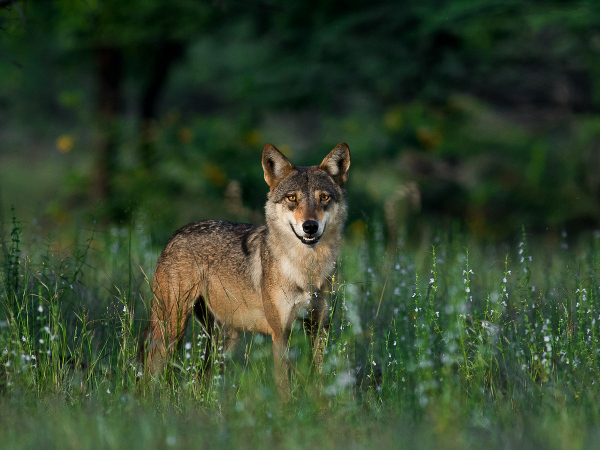Indian grey wolves use four kinds of sounds to communicate different messages with each other, a first-of-its-kind study by wildlife researchers reveals.
The study – Characterising the harmonic vocal repertoire of the Indian wolf – published in the international peer-reviewed research journal Plos One on October 31, is based on the analysis of 270 recorded vocalisations from wild and captive Indian grey wolf populations.
Researchers found that the wolves used distinct sounds – howls, howl-barks, whimpers, social squeaks, and whines – each indicating different aspects of the animal’s social behaviour.
Vocalisation plays a critical role in conveying information on foraging, reproduction, safety and other behaviours among social animals, the study said.
Bilal Habib and Sougata Sadhukhan, researchers from the Wildlife Institute of India (WII), with Lauren Hennelly from the Mammalian Ecology and Conservation Unit, Veterinary Genetics Laboratory, University of California, USA, used howl survey responses for 10 captive wolves at Jaipur Zoo and recordings for nine packs (of two to nine individuals) of free-ranging wolves at 150 locations in tropical dry and moist deciduous forests and grasslands of Ahmednagar, Solapur, Pune, Aurangabad, Nagpur and Chandrapur districts in Maharashtra. The surveys were carried out between November 2015 and June 2016.
“Vocalisations were identified based on the level of frequency, to assess individual-specific variations within a population. To put it simply, our mind can differentiate between the voices of different people, attaching an identity to each voice. Similarly, there are different calls made by animals and we were able to differentiate these sounds. We went a step ahead and tried to understand them using statistical tools,” said Habib.
While the first category – ‘howl’ (high frequency) was the most detectable form of long-range communication and territorial announcement, ‘howl barks’ (low pitched) were in defence to any immediate threat. For example, in one instance, a she-wolf started barking at nearby villagers to protect her pups. She did not stop until all three pups were a safe distance from the villagers.
Other vocalisations involved lesser-studied short-range communications such as the whimper (low intensity but high-pitched) used for short-distance communication among pack members. The third category ‘social squeak’ is similar to ‘talking’ but is under-researched; and lastly, the ‘whine’ is mainly used during stressful situations such as pack separation, intra-pack conflict or nursing of pups.
“This is a new discipline called soundscape ecology, which explains how other sciences can help understand wildlife better. These studies open up new avenues for wildlife conservation,” added Habib.
The Indian grey wolf is protected under schedule I of the Wildlife Protection Act, 1972. An early 2000 study guesses that there might be 3,000 wolves in the country but it has never been followed up through any organised official estimate.
“Wolves were chosen because these species are not identifiable by any patterns on their body [cryptic]; not seen during the day, and are elusive enough not be photographed easily in camera traps. Their ability to communicate across large distances using the howl was also a reason for their selection,” said Habib. “Similar studies can be used for tigers, wild dogs [whistling hunters] or even frogs,” he said.
In an email response to Hindustan Times, Lauren Hennelly from the Mammalian Ecology and Conservation Unit, Veterinary Genetics Laboratory, University of California Davis, USA, said, “Wolves are highly social animals and use many types of vocalisations to communicate with each other. Our goal was to characterise the different types of vocalisations that Indian wolves use in their daily lives, which is called a vocal repertoire. This is the first step to understanding how Indian wolves communicate with each other using different vocal signals.”
She explained that bioacoustics is an increasingly emerging tool in conservation, allowing researchers to identify individuals for population monitoring and create inventories of biodiversity-based on animal voices. “Since wolves are elusive and their paw prints can often be confused with those of dogs, monitoring their populations using their howls offers a promising avenue. Howl surveys can provide important information for studying and conserving wolves, such as estimating the number of wolves in a pack and determining if pups are presently based on their howl responses. By statistically characterising Indian wolf howls from other vocalisations, our study provides the groundwork for applying these exciting techniques to conserve Indian wolves.”
Source: HT
Image Courtesy: Wikimedia
You may also like
-
New Heat-Based Approach To Cancer Treatment Can Reduce Chemotherapy Doses
-
Scientists Take A Major Step Towards Unification Of Classical & Quantum Gravity
-
India Graphene Engineering and Innovation Centre (IGEIC) Under the Vision of Viksit Bharat@2047 Launched
-
New High-Performance Gas Sensor can Monitor Low Level Nitrogen Oxides Pollution
-
Antidepressant Drug can be Repurposed for Treating Breast Cancer
